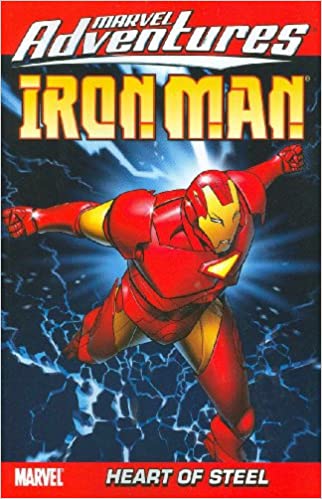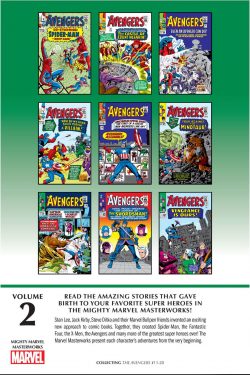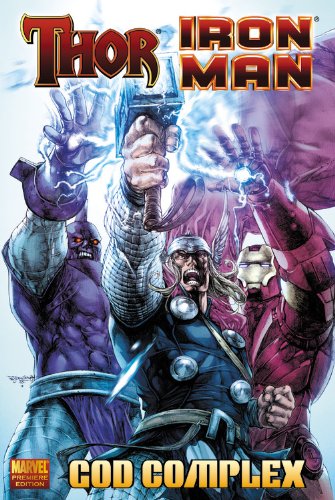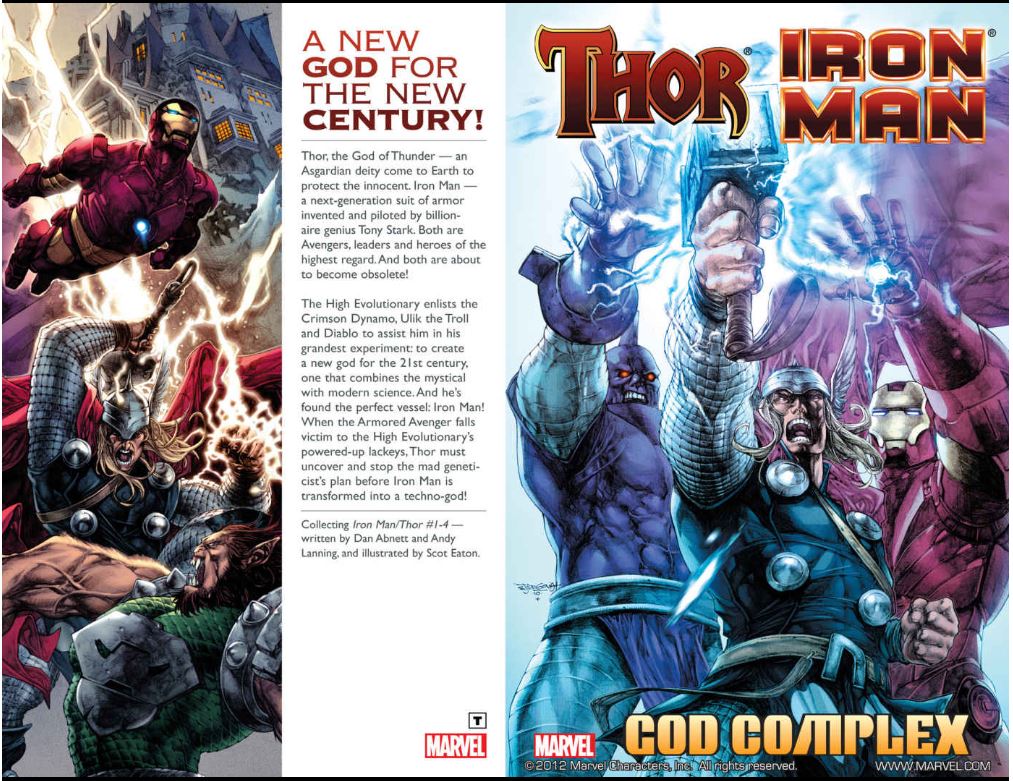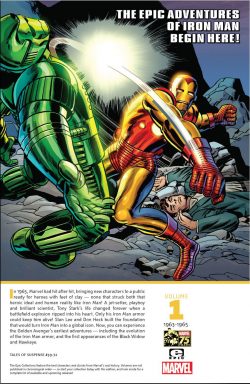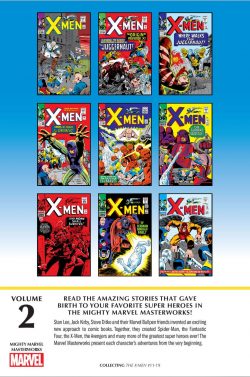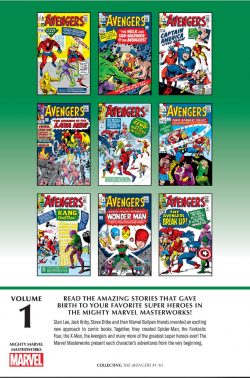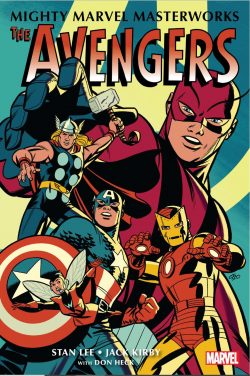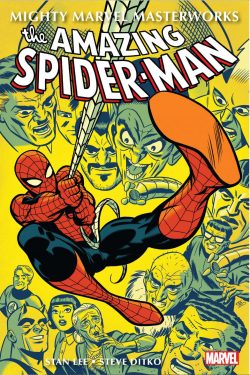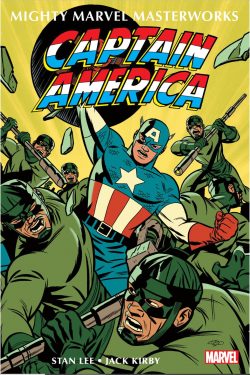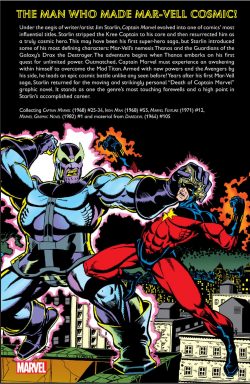
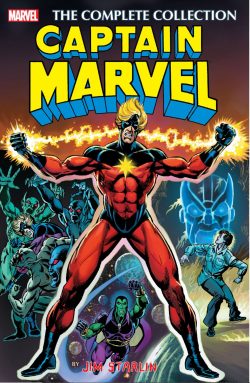
By Jim Starlin, Mike Friedrich, Steve Gerber, Steve Englehart & various (Marvel)
ISBN: 978-1-30290-017-5
50 YEARS!! It’s been five decades since this tale was first told! If you don’t know why, you have a real treat in store…
As much as I’d love to claim that Marvel’s fortunes are solely built on the works of Jack Kirby and Steve Ditko, I’m just not able to. Whereas I can safely avow that without them the modern monolith would not exist, it is also necessary to acknowledge the vital role played by a second generation of creators of the early 1970s. Marvel’s eager welcome to fresh, new, often untried talent paid huge dividends in creativity and – most importantly at a time of industry contraction – resulted in new sales and the retention of a readership that was growing away from traditional comics fare. Best of all, these newcomers spoke with a narrative voice far closer to that of its rebellious audience…
One of the most successful of these newcomers was Jim Starlin. As well as the topical and groundbreaking Master of Kung Fu – co-created with his equally gifted confederates Steve Englehart & Al Milgrom – Starlin’s earliest success was the epic of cosmic odyssey compiled here.
Captain Marvel was an alien on Earth, a defector from the militaristic Kree. He fought for Earth and was atomically bonded to professional sidekick Rick Jones by a pair of wristbands allowing them to share the same space in our universe. When one was here, the other was trapped in the antimatter dimension designated the Negative Zone.
After meandering around the Marvel Universe for a while, continually one step ahead of cancellation (the series had folded many times, but always quickly returned – primarily to secure the all-important Trademark name), Mar-Vell was handed to Starlin – and the young artist was left alone to get on with it.
With many of his fellow neophytes, he began laying seeds (particularly in Iron Man, Sub-Mariner and Daredevil) for a saga that would in many ways become as well-regarded as the Jack Kirby Fourth World Trilogy that inspired it. However, the Thanos War, despite many superficial similarities, would soon develop into a uniquely modern experience. And what it lacked in grandeur, it made up for with sheer energy and enthusiasm…
This epic compendium gathers and collates Iron Man #55, Captain Marvel #25-34, Marvel Feature #12 and pertinent extracts from Daredevil #105. It collectively spanning February 1973 to September 1974, and concludes with the landmark Marvel Graphic Novel #1 from 1982: thus re-presenting Starlin’s entire input into the legend of the Kree Protector of the Universe and one of the company’s most popular and oft-reprinted sagas.
The artistic iconoclasm began in Iron Man #55 (February 1973) where Mike Friedrich scripted Starlin’s opening gambit in a cosmic epic that would change the nature of Marvel itself.
Inked by Mike Esposito, ‘Beware… Beware… Beware the… Blood Brothers!’ introduces formidable and obsessive Drax the Destroyer: an immensely powerful apparent alien trapped under the Nevada desert and in dire need of rescue thanks to the wiles of even more potent extraterrestrial invader Thanos…
That comes when the Armoured Avenger blazes in, answering a mysterious SOS, but only after brutally dealing with the secret invader’s deadly underlings…
All this is merely a prelude to the main story which begins unfolding a month later in Captain Marvel #25, courtesy of Friedrich, Starlin, & Chic Stone wherein Thanos unleashes ‘A Taste of Madness!’ and exiles Mar-Vell’s fortunes change forever…
When ambushed by a pack of extraterrestrials, Mar-Vell is forced to admit that his powers have been in decline for some time. Unaware that an unseen foe is counting on that, he allows Rick to manifest (from the Negative Zone) and they check in with sagacious scientific maverick Dr. Savannah. Suddenly, Rick is accused by the savant’s daughter (and Rick’s beloved) Lou-Ann of her father’s murder…
Hauled off to jail, Rick brings in Mar-Vell who is suddenly confronted by a veritable legion of old foes before deducing who in fact his true enemies are…
Issue #26 then sees Rick freed from police custody to confront Lou-Ann over her seeming ‘Betrayal!’ (Starlin, Friedrich & Dave Cockrum). Soon, however, he and Mar-Vell realise they are the targets of psychological warfare: the girl is being mind-controlled whilst Super Skrull and his hidden “Masterlord” are manipulating them and others in search of a lost secret…
When a subsequent scheme to have Mar-Vell kill The Thing spectacularly fails, Thanos takes personal charge. The Titan is hungry for conquest and needs Rick because his subconscious conceals the location of an irresistible ultimate weapon.
Jones awakens to find himself ‘Trapped on Titan!’ (Pablo Marcos inks) but does not realise the villain has already extracted the location of a reality-altering Cosmic Cube from him. Rescued by Thanos’ hyper-powered father Mentor and noble brother Eros, the horrified lad sees first-hand the extent of the genocide the death-loving monster has inflicted upon his own birthworld. Utterly outraged, he summons Captain Marvel to wreak vengeance…
Meanwhile on Earth, still-enslaved Lou-Ann has gone to warn the Mighty Avengers and summarily collapsed. By the time Mar-Vell arrives in #28 she lies near death. ‘When Titans Collide!’ (inks by Dan Green) reveals another plank of Thanos’ plan. As the heroes are picked off by psychic parasite The Controller, the Kree Captain is assaulted by bizarre visions of an incredible ancient being. Fatally distracted, he becomes the malevolent mind-leech’s latest victim…
Al Milgrom inks ‘Metamorphosis!’ as Mar-Vell’s connection to Rick is severed before the Kree is transported to an otherworldly locale where a grotesque eight billion-year-old being named Eon reveals the origins of universal life whilst overseeing the lifelong soldier’s forced evolution into an ultimate warrior: a universal champion gifted with the subtly irresistible power of “Cosmic Awareness”…
Iron Man, meanwhile, has recovered from a previous Controller assault and headed for Marvel Feature #12 to join Ben Grimm in ending a desert incursion by Thanos’ forces before enduring ‘The Bite of the Blood Brothers!’ courtesy of Friedrich, Starlin, & Joe Sinnott, after which the story develops through an extract first seen in Daredevil #105.
Here enigmatic and emotionless super scientist Madame MacEvil tells her origins and foreshadows her future role in the cosmic catastrophe to come. When Thanos killed her family, the infant Heather Douglas was adopted by Mentor, taken to Titan and reared by psionic martial artists of the Shao-Lom Monastery. Years later when Thanos attacked Titan and destroyed the monks, she swore revenge and took a new name – Moondragon…
Subsequently returned to Earth and reconnected to his frantic atomic counterpart, the newly-appointed “Protector of the Universe” confronts The Controller, thrashing the monumentally powerful brain-parasite in a devastating display of skill countering exo-skeletal super-strength in #30’s ‘…To Be Free from Control!’ after which #31 celebrates ‘The Beginning of the End!’ (inked by Green & Milgrom) as the Avengers – in a gathering of last resort – are joined by psionic priestess Moondragon and Drax. The latter is revealed as one more of Thanos’ victims, but one recalled from death by supernal forces to destroy the deranged Titan…
The cosmic killer is then revealed as a lover of the personification of Death: determined to give her Earth as a betrothal present. To that end he uses the Cosmic Cube to turn himself into ‘Thanos the Insane God!’ (Green inks) who, with a thought, imprisons all opposition to his reign. However, his insane arrogance leaves cosmically aware Mar-Vell with a slim chance to undo every change, and the last hero brilliantly outmanoeuvres, defeats and apparently destroys ‘The God Himself!’ in the cosmically climactic Captain Marvel #33 (inked by Klaus Janson)…
With the universe saved and a modicum of sanity and security restored, Starlin’s run ended on a relatively weak and inconclusive note in #34 as ‘Blown Away!’ – inked by Jack Abel and dialogued by Englehart – explored the day after doomsday…
As Rick strives to revive his on-again, off-again musical career, a new secret organisation called the Lunatic Legion sends Nitro, the Exploding Man to acquire a canister of deadly gas from an Air Force base where old pal Carol Danvers (long before her transformations into Ms. Marvel, Binary, Warbird and ultimately Captain Marvel) is head of Security…
Although the Protector of the Universe defeats his earth-shattering enemy, Mar-Vell succumbs to the deadly nerve agent released in the battle. The exposure actually kills him but he will not realise that for years to come…
In 1982, The Death of Captain Marvel was the first Marvel Graphic Novel and the one that truly demonstrated how mainstream superhero material could breach the wider world of general publishing.
Written and illustrated by Starlin with lettering by James Novak and colours from Steve Oliff, this tale concluded the career of the mighty Kree Champion in a neatly symmetrical and textually conclusive manner – although the tale’s success led to some pretty crass commercialisations in its wake…
As previously stated, Mar-Vell was an honoured soldier of the alien Kree empire dispatched to Earth as a spy, who went native: becoming first a hero and then the cosmically “aware” Protector of the Universe, destined since universal life began to be its stalwart cosmic champion in the darkest hours.
In concert with the Avengers and other heroes, he defeated death-worshipping Thanos, just as that villain became God, after which the good Captain went on to become a universal force for good.
That insipid last bit pretty much sums up Mar-Vell’s later career: without Thanos, the adventures again became uninspired and eventually just fizzled out. He lost his own comic book, had a brief shot at revival in try-out title Marvel Spotlight and then just faded away…
Re-enter Starlin, who had long been linked to narrative themes of death. He offered a rather novel idea – kill Mar-Vell off and actually leave him dead. What no fan realised at the time was that Starlin was also processing emotional issues thrown up by the passing of his own father and the story he crafted echoed his own emotional turmoil.
In 1982, killing such a high-profile hero was a bold idea, especially considering how long and hard the company had fought to obtain the rights to the name (and sure enough there’s always been somebody with that name in print ever since) but Starlin wasn’t just proposing a gratuitous stunt. The story developed into a different kind of drama: one uniquely at odds with contemporary fare and thinking.
Following the Thanos Saga, Mar-Vell defeated second-rater Nitro but was exposed to experimental nerve gas during the fight. Now years later he discovers that, just as he has found love and contentment, the effects of that gas have inexorably caused cancer in his system. Moreover, it has metastasized into something utterly incurable…
Going through the Kree version of the classic Kubler-Ross Cycle: grief, denial, anger, bargaining, depression and acceptance, the Space-Born hero can only watch as all his friends and comrades try and fail to find a cure, before death comes for him…
This is a thoughtful, intriguing examination of the process of dying observed by a being who never expected to die in bed, and argues forcefully that even in a universe where miracles occur by the hour sometimes death might not be unwelcome…
Today, in a world where the right to life and its intrinsic worth and value are increasingly being challenged and contested by special interest groups, this story is still a strident, forceful reminder that sometimes the personal right to dignity and freedom from distress is as important as any and all other Human Rights.
No big Deus ex Machina, not many fights and no happy ending: but still one of the most compelling stories the House of Ideas ever published.
Augmenting the sidereal saga, a number of now-mandatory bonus bits include Starlin’s exploded-view map-&-blueprint of Thanos’ homeworld Titan; original cover art from Captain Marvel #29 plus original art and the 3-page framing sequence for the reprint issue #36.
Other extras follow: the all-cosmic hero cover to fan-magazine F.O.O.M. #19; the all-new covers, back covers and bridging pages for prestige reprint miniseries The Life of Captain Marvel (as well as the humorous introductory ‘Editori-Al’ strips cartooned by Al Milgrom) and much, much more.
A timeless classic of the company and the genre, this is a tale no full-blooded Fights ‘n’ Tights fan can be without.
© 1972, 1973, 1974, 1982, 2016 Marvel Characters, Inc. All rights reserved.

